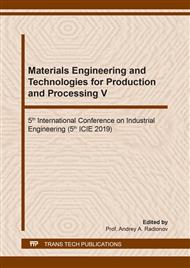[1]
Yan Li Shuxia Ren, Building Decorative Materials, first ed., Woodhead Publishing, (2011).
Google Scholar
[2]
Haimei Zhang, Building Materials in Civil Engineering, first ed., Woodhead Publishing, (2011).
Google Scholar
[3]
Ravindra K. Dhir OBE Jorge de Brito Gurmel S. Ghataora Chao Qun Lye, Sustainable Construction Materials, first ed., Woodhead Publishing, (2018).
Google Scholar
[4]
W.E. Worrall, Ceramic Raw Materials, Pergamon, (1982).
Google Scholar
[5]
F. Franklin, Y. Wang, Ceramic Fabrication Processes, first ed., Academic Press, (1976).
Google Scholar
[6]
Alan G. King, Ceramic Technology and Processing, first ed., William Andrew, (2002).
Google Scholar
[7]
B.H. Howard, J.W. Lekse, Clay Mineralogy. In: Romanov V. (eds) Greenhouse Gases and Clay Minerals. Green Energy and Technology, Springer, Cham, (2018).
DOI: 10.1007/978-3-319-12661-6_4
Google Scholar
[8]
W. Ryan, Properties of Ceramic Raw Materials, Pergamon, (1978).
Google Scholar
[9]
V.V. Mikhalev, A.S. Vlasov, Properties of clays for manufacturing sanitary ware, Glass Ceram. 64 (2007) 78-81.
DOI: 10.1007/s10717-007-0019-2
Google Scholar
[10]
V.K. Sturman, V.S. Alimov, A Feasibility Analysis and Prospects for Commercial Use of Clays from the Shulepovskoe Deposit in Ryazan Region, Refractories and Industrial Ceramics. 43 (2002) 362-364.
Google Scholar
[11]
T.N. Dolgikh, A.K. Karklit, Clay raw material of Berezovka deposit, Refractories. 34 (1993) 394-398.
DOI: 10.1007/bf01602703
Google Scholar
[12]
I.A. Pavlova, I.D. Kashcheev, K.G. Zemlyanoi et al, Tyumen Clays in the Production of Building Ceramic, Glass Ceram. 72 (2016) 341-344.
DOI: 10.1007/s10717-016-9787-x
Google Scholar
[13]
A.A. Mikhailova, A.V. Ivanova, E.G. Vovkotrub et al, Ural clays for building brick production, Glass Ceram. 55 (1998) 158-160.
DOI: 10.1007/bf02694731
Google Scholar
[14]
V.P. Rat'kova, N.D. Yatsenko, G.N. Ivanyuta et al, Optimization of clay properties for selecting brick molding method, Glass Ceram. 61 (2004) 379-381.
DOI: 10.1007/s10717-005-0007-3
Google Scholar
[15]
S. Mahmoudi, E. Srasra & F. Zargouni, Identification and Simultaneous Optimisation of Tunisian Clay Properties: Preliminary Study for the Ceramic Products, Geotech Geol Eng. 34 (2016) 817-825.
DOI: 10.1007/s10706-016-0005-y
Google Scholar
[16]
I. Ozkan, Densification behavior of red firing Menemen clay, J. Aust. Ceram. Soc. 51 (2015) 36-39.
Google Scholar
[17]
Clay raw materials. Test methods, GOST 21216-2014.
Google Scholar
[18]
Clayish materials for ceramic industry. Classification, GOST 9169-75.
Google Scholar
[19]
Ceramic brick and stone. General specifications, GOST 530-(2012).
Google Scholar
[20]
Ceramic tiles. Specifications, GOST 56688-2015.
Google Scholar
[21]
Brown ware. General specifications, GOST 32092-2013.
Google Scholar


